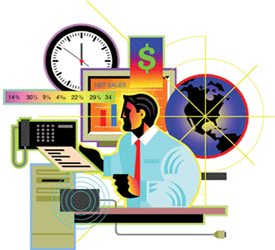|

When Christopher Kent was a graduate student, he studied the history of medieval Europe. But that’s all in the past. These days, Christopher uses his skills to study the future.
Christopher is a futurist. He examines the present for clues to changes that the future may bring. His training in history serves him well. “As a historian, you usually deal with incomplete information,” he says. “You look at disconnected clues and information to piece together a story about the past. A futurist looks at clues and information from today to piece together stories for the future.”
Futurists specialize in recognizing upcoming uncertainty and attempting to manage it. They realize that unknown—and unknowable—changes will shape the future. By identifying a range of possible changes, these workers develop alternate visions of the future.
There are different types of futurists, and each type has different methods, motives and objectives. For example, some futurists’ work is primarily academic and focuses on social criticism. Others, like Christopher, are professional futurists: They help paying clients—either organizations or individuals—anticipate change and make plans and adjustments accordingly.
Professional futurists begin work on a project by defining a client’s goals. Then, they typically gather relevant information from media reports, statistical databases, and other sources. Futurists’ skill lies in the ability to recognize connections in scattered bits of information.
These connections are often a sign of emerging trends, and identifying them allows futurists to forecast likely and alternative futures.
Alternative futures are presented in a variety of ways. Futurists may develop narratives describing different paths that the future may follow. Or, they may forecast possible futures confronting a specific industry or product line.
Both the methods used and the project’s final product are tailored to fit the client’s needs. “One client wanted us to look at how different trends influenced specific generations over the course of 10 years,” Christopher says by way of example. “We developed an interactive, color-coded timeline that allowed the client to see the work graphically.”
Christopher and his colleagues spend some of their time working on clients’ custom research projects. The focus of such projects may be narrow, such as analyzing the future prospects of a single product; other projects may be as broad as forecasting the future of an entire industry. Futurists at Christopher’s firm also work on self-directed research projects for a research database available to subscribers.
One thing futurists do not do, says Christopher, is make predictions. “The P-word is a loaded term,” he says. “The future can’t be predicted accurately, because it is unknown.” Rather than tell clients what will happen, in other words, futurists identify what could happen.
A few professional futurists are self-employed, but most, like Christopher, work for futures consulting companies. Some of these companies focus on specific topics or industries. Others, including Christopher’s firm, deal with a range of topics and have a broad clientele. Clients of Christopher’s firm include private companies, government agencies, and nonprofit organizations.
In most firms, projects are assigned to teams based on analysts’ interests, experience, and expertise. But opportunities to work on more general projects allow futurists to gain new proficiencies. “I enjoy working with colleagues on projects outside my specialization,” says Christopher. “It gives us all a broader base of knowledge, which can be useful in all projects.”
The U.S. Bureau of Labor Statistics does not specifically track the employment and wages of futurists. And because futurism is a broad, interdisciplinary field, these workers may have a variety of occupational titles. Anecdotal information suggests that there are between 500 and 1,000 professional futurists working in the United States.
There are formal programs in futures studies at several U.S. and international universities. Although graduates of these programs may have an advantage in the field, there are no formal educational requirements for becoming a futurist. Most employers prefer applicants who have at least a bachelor’s degree in any subject.
Christopher has a bachelor’s degree, with a double major in English and history, in addition to his master’s degree.
After graduating from college, Christopher worked in Washington, D.C., as a public policy analyst, forecasting political trends 6 to 9 months out. He enjoyed forecasting and felt that a move to analyzing longer-term futures was a logical next step. So, when an opportunity arose in the firm where he now works, Christopher decided to pursue the challenge.
Futurists need to be inquisitive, critical, and creative. They also must be comfortable with uncertainty. And they should have the imagination necessary to envision major disruptive events—but be able to let solid research guide that imagination.
Christopher recommends the occupation for those who like research and variety. “This is a perfect job,” he says, “for people who are intensely curious and get bored easily.”
 Top Top
|



